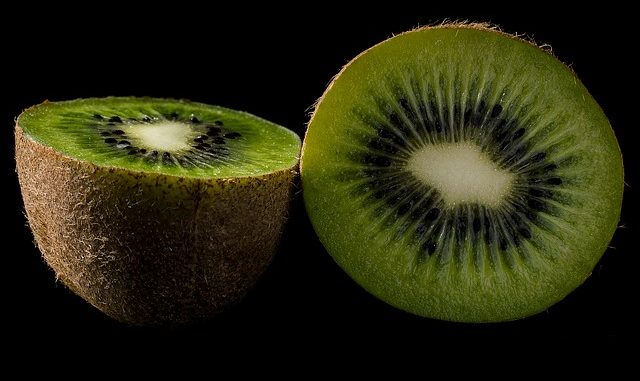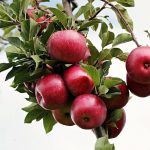
Kiwi fruit (Actinidia chinensis) has a beautiful green flesh which almost shines out with its goodness. Nutritionally, kiwifruit is commonly reported to be a good source of vitamin E and in addition contain beneficial phenolics and carotenoids. One of the most popular products using kiwi fruit is the fruit leather which is fruit puree concentrate that is dehydrated to a point where it forms a pliable food stuff. As the name suggests, it has quite a leathery texture but is full of vitamins, minerals and fibre. Nowadays, kiwi fruits are recommended for a host of health issues, especially constipation.
The fruit is actually a large berry with edible seeds. The peel can be consumed but it is not as tasty as the pulp/flesh.
A large body of research has been conducted by the Horticulture and Food Research Institute of New Zealand in Auckland, New Zealand on this fruit and much of the knowledge comes from this institute.
Kiwi Fruit Componentry
Kiwifruit pulp contains plenty of phenolic compounds which have been examined using reversed-phase HPLC (Dawes & Keene, 1999). The clarified juice contains between 1 and 7 mg/l. Heat treatment of the juice produces derivatives of these phenolics which implies that processing has a positive impact on the fruit.
Most of these are derivatives of coumaric and caffeic acids. Compounds of note include chlorogenic acid, protocatechuic acid, and a derivative of 3,4-dihydroxybenzoic acid. Epicatechin, catechin and procyanidins ((B3, B2, or B4 and oligomers) have also been identified.
The flavonols are glycosides of quercetin (glucoside, rhamnoside, and rutinoside) and kaempferol (rhamnoside and rutinoside).
The flavonol glycosides are suggested as the best markers of key fruit and a way of identifying adulteration.
The proanthocyanidins in what is the pulp (pericarp) were separated into three fractions (Chai et al., 2014). A combination of analytical methods including MALDI-TOF MS and HPLC-ESI-MS revealed a complex mix of of B-type propelargonidins, procyanidins, procyanidins gallate, and prodelphinidins. These components strongly inhibit tyrosinase which is often involved in enzymatic browning reactions when released into pulp. All these components also have very strong antioxidant activity.
A number of researchers postulate that kiwi fruit pericarp proanthocyanidins could serve as insecticides, food preservatives, and cosmetic additives.
The fruit also contains chlorophylls a and b and the carotenoids normally associated with photosynthesis, β-carotene, lutein, violaxanthin, and 9‘-cis-neoxanthin. Generally, all the kiwi fruit species contains these components but A. chinensis also contains esterified xanthophylls (McGhie & Ainge, 2002).
Fruit Processing
Kiwifruit is noted for its extremely firm texture when fresh. The fruit is often used, sliced in high end fruit salads.
Typical quality factors for kiwi fruit as with many fruits are the following:-
- soluble solids content
- weight loss
- textural changes
- surface colours based on lightness, hue angle and chroma.
The European Commission has set a standard that kiwifruit for sale must be at least 65g. Any underweight would be suitable for other types of food products such as fruit leather and snacks (EC, 2004).
Kiwifruit is very susceptible to poor treatment once picked. Poor storage and handling however will often reduce the value of the fruit because it is damaged and bruised.
Minimal processing as it is often called can lead to a number of deleterious reactions. These include loss of firmness and colour with a rise in browning as well as a fading of the green colour, rising respiration and high ethylene production. Some of the damage is caused a rise in released enzymes as a result of wounding.
The main issue of sliced kiwi fruit is softening – the principal quality loss indicator. Sliced kiwi fruit can be stored effectively at 0-2ºC and for much longer than stored at 5 to 10ºC (Agar et al., 1999). The post-cutting life when based on visual appearance was 2 days at 4ºC and shorter than 6 days at 5ºC.
Pre-treatments maintain texture relatively well (Costa et al., 2006). A mild heat treatment by immersing the fruit in water for about 40 minutes at temperatures just below 45 ºC appears to be optimal. Other approaches include preservation of the sliced fruit by treatment with 1-methylcyclopropene (1-MCP) before the fruit is actually cut, unconventional packaging with different types of modified atmospheric conditions as in the use of an inert gas such as argon with nitrous oxide (Rocculi et al., 2005). Volatile compounds too can work effectively such as ethanol, higher alcohols and methyl jasmonate (Wang et al., 2003). Another effective treatment has been the application of hydrogen peroxide with calcium lactate in a controlled atmosphere packaging.
Kiwi Fruit Nutrition
A medium sized kiwi fruit contains on average 2.5 grams of fiber with plenty of vitamins, minerals and other nutrients that are important for maintaining good health. The greatest benefit comes partly from the dietary fibre which helps us maintain our digestive system.
Variety and cultivar are the main factors affecting nutritional value and quality (Ma et al., 2017).
Treatment For Constipation
Numerous anecdotal reports comment that kiwifruit has laxative effects. For many it would be an acceptable alternative to taking senna even as a dietary supplement, especially for the elderly who often experience constipation (Rush et al., 2002). It has been reported that the dietary fiber in kiwifruit is about 3.4 g/100 g, so it is a good source of dietary fiber. One study in Chinese patients found that the fibre from kiwi fruit helped with alleviating constipation (Chan et al., 2007).


I find kiwi fruit too sweet for me and they give me terrible indigestion. My grocery store sells a golden variety which they also dry. I would like to find a variety that is a bit more sour but not so acidic. I think that kiwi needs to be cut up into small pieces to be any useful in fruit salads.